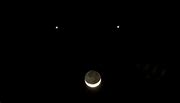Have you ever looked up at the night sky and seen a celestial smile looking back at you? Well, get ready for a whimsical treat because on May 29th, the moon will team up with the stars Castor and Pollux to form what appears to be a smiling face in the heavens. Imagine gazing up at a lopsided grin beaming down upon you from above.
Picture this: as the sun sets, allowing darkness to descend, skywatchers in the U.S. will witness this delightful cosmic display about 45 minutes post-sunset. The brightest stars will start peeking through the darkening sky, setting the stage for this unique event. The slender crescent of the moon will hang just over 20 degrees above the horizon, resembling a quirky smile. And there they are – Castor on one side (the right) and Pollux on the other (the left), acting as the “eyes
” of this celestial emoji.
But how do we measure these distances in space? As an expert would explain, “
An easy way to gauge distances between celestial objects is by using your hand against the night sky.” When you hold your fist at arm’s length and stretch out your fingers, that span covers roughly 10 degrees – helping us appreciate how close or far apart these cosmic elements truly are.
As night unfolds further, viewers in different locations across America will have varying windows of opportunity to witness this magical alignment before it gracefully disappears beneath the horizon around midnight local time. To catch such fleeting moments of beauty in our vast universe requires timing and patience.
Now let’s dive into some fascinating background information about our stellar actors – Castor and Pollux. These names originate from Greek mythology where they represent twin deities within Gemini’s zodiacal constellation. Pollux, named after Zeus’ son, shines brightly like Mars but as a red giant star. On May 29th, you can spot it gleaming towards Gemini’s twin stars’ upper left after sunset.
While Pollux radiates with majestic brilliance, its mythological counterpart Castor has an intriguing twist. Unlike its sibling star system which appears singular but is actually multiple stars orbiting each other – six stars in total! This complexity mirrors their mortal heritage in Greek mythology as counterparts embodying both human-like qualities alongside their divine origins.
As we marvel at this celestial show unfolding above us, remember that these astronomical displays offer more than just visual delight; they provide insights into our universe’s vast wonders and mysteries waiting to be explored.
So whether you’re an avid stargazer or someone simply drawn to nature’s beauty, take a moment on May 29th to look up at the night sky and witness this enchanting ‘smiley face’ formed by nature’s own handiwork – reminding us of the magical harmony that exists beyond our earthly realm.








Leave feedback about this